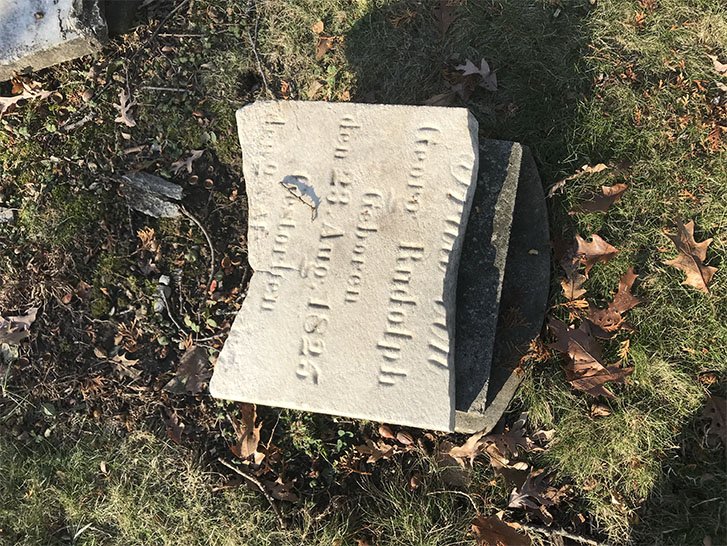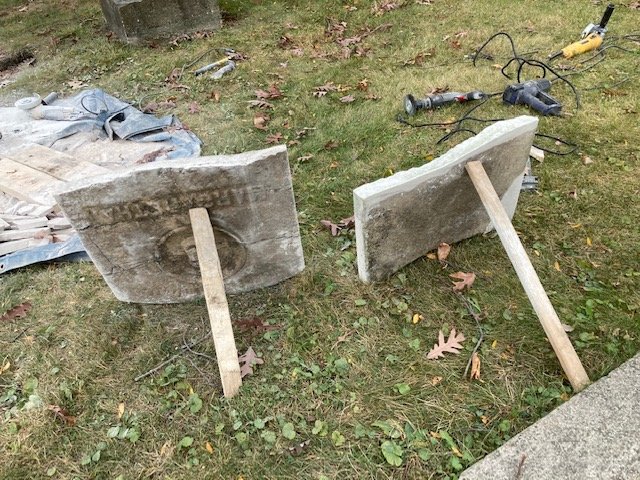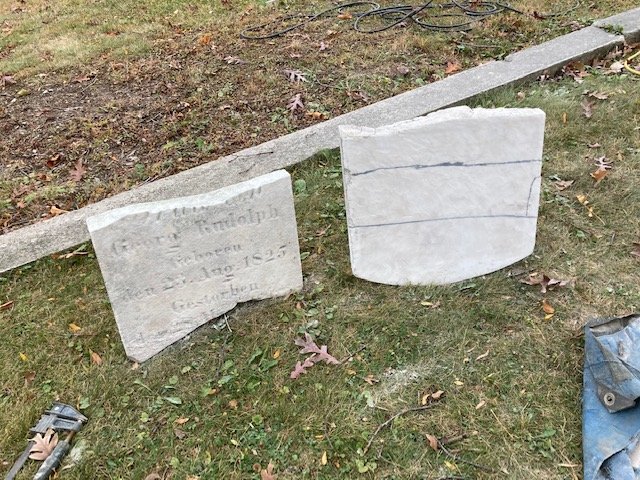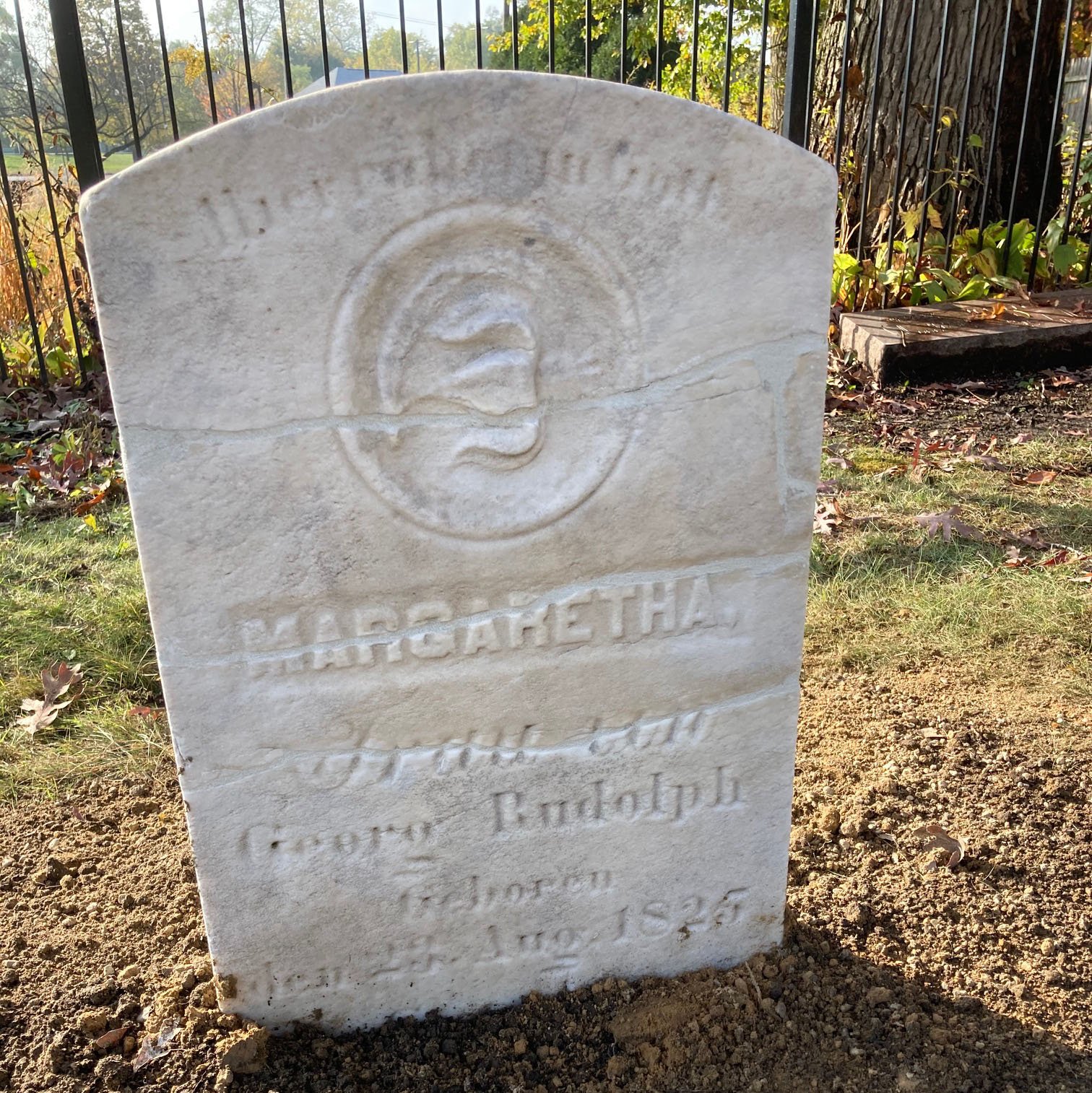Daggitt Cemetery (also called Grace, sometimes Braeside, or spelled Daggett) was essentially abandoned until taken over by the Township in 1996.
The cemetery is located on Lake Cook (County Line) Road [aerial view PDF] near the Braeside Metra station. Like many pioneer cemeteries, it began as a portion of a family homestead where possibly of necessity, family members came to be buried. Whereas Mooney’s story concerns Irish Catholics, Daggitt’s is about pioneering Protestants – Methodist English and Lutheran German settlers. The likely earliest one, Robert Daggitt (originally Daggett), sadly found that his carpentry skills were employed in building coffins for three of his own nine children after emigrating from England and arriving in this area in 1837 (possibly1839*). Two daughters, Ann, 13, and Rachel, 21, died of “quick consumption” (tuberculosis), in 1845 and 1847, followed in 1848 by a son, James, 18, injured by a falling tree. Daggitt allowed neighbors to use this half-acre of his property as well, eventually purchasing a state charter for the burial ground, and charging $1 per grave. (Daggitt’s holdings grew to variously reported 1150-3000 acres, from near the lake westward; his sheep were said to graze on what is now Ravinia Park, and his land included the present day Chicago Botanic Gardens.) Wittelle’s account says that he was aware of impoverished neighbors burying small infant caskets unseen at night, into unmarked graves; Synderman relates that during a cholera epidemic of the 1850s, Daggitt donated gravesites for his neighbors’ use. Many of those neighbors were from Germany and had founded a Lutheran church along County Line Road (whose boundaries were fluid for a time, between Highland Park and Glencoe, Lake and Cook counties).
In 1862, Robert and Elizabeth Daggitt legally transferred the family burial ground to a group of specifically enumerated local residents “and such persons as may hereafter become associated with them,” with John Fehd and “Robert Daggitt, Jr.” named initial co-trustees. We surmise that the latter is most likely the same Robert, since no “junior” appears again, and Ancestry.com lists his father as Robert as well. The tract was to be known as Grace Cemetery (misspelled in the historic documents as “Semetteray”). Transaction records are on file at the Township office, and in PDF format on our website, along with other documentation for this article. The transaction of 1862 was recorded in 1871 (page 3 of the PDF). It also lists specific lot numbers reserved as “family burying ground” that you can see marked on the 1887 plat.
Robert died in 1871. "Grace Cemetery" was platted and registered in 1887, with Robert’s son Joseph Daggett [sic], and John Fehd named as co-trustees. The last cemetery legal transactions on record occur in 1910, as researched by the City of Highland Park around 1985, when the property was in disrepair and responsibility for its maintenance was sought.
Oral histories don’t completely agree about the details, and record-keeping seems to have been conducted within the individual families on behalf of the extended Daggitts and their German ancestry neighbors. A great many markers are in German, in fact. We have very little information about the other pioneer families buried at Daggitt, but many well-known names prominent in Glencoe and Highland Park histories can be found there.
Over the years, local preservationists and various genealogists have attempted to create order or track down the cemetery’s history; inventories from 1959 and 1986 are in Township files; a USGenWeb online “reading” is from 2002. Julia Johnas, during her tenure at the Highland Park Public Library, was helpful in researching records, as were personnel from the Lake County Recorder’s Office, who provided scanned archival information. The Internet has been a boon to our research.
English heritage family descendants [family chart of those buried at Daggitt] like Joseph Daggitt’s great-niece, Rose Dennis Booth [oral history] of Glencoe, [unattributed pre1941 news article] attempted to maintain the property, but could not keep up with the vandalism. Interviewed at age 79 in 1974, she told Snyderman that Charles Dennis, her father, had deeded the grounds to the City of Highland Park in 1941, to remain permanently a cemetery or revert to a public park. No such records were found, according to March, 1987 news reporting by Verstraete. In a 1978 letter to her, Township Supervisor Robert Moroney inquired about “Braeside Cemetery,” as it was also popularly known, but the files do not contain her reply. Mrs. Booth died in 1984 and was, as far as we know, the last person buried at Daggitt. No marker with her name on it has been found, and the funeral home managing the burial had no specific information. The cemetery is closed to new burials.
Decades of neglect and vandalism, Halloween nights of fun and mayhem, theft of marble markers for baking use and nature’s destruction of inscriptions on soft stone make tracing many of the family histories difficult or impossible. In 1996, through cooperative legal and clean-up efforts by the City and Park District of Highland Park, Daggitt Cemetery became the responsibility of Deerfield/now Moraine Township.
In 2020, Moraine Township undertook a 3-year restoration project at Daggitt Cemetery to repair and restore historic stones. Gravestones that were previously tilted, broken and filthy are now clean, upright and standing in rows. The cleaned marble and limestone appear to be new. Epoxy was used to repair broken markers and water pressure to clean surfaces. Missing and damaged marker base stones have been restored. Previously illegible inscriptions can be read for the first time in decades and tell stories of our community’s history. Several gravestones have revealed names of people who do not appear on inventories taken in 1959 and 1986. Below is an example of the process of repairing the marker for Margaretha Rudolph which was found broken into four pieces.
* Daggitt family tradition claimed 1837, a year they also said Robert and family arrived on the Benjamin Franklin but that ship's passenger inventory on Ancestry.com lists a family group that seems to be our Daggitts on a voyage in 1839. However, because of transcription errors, the 9 could have been a 7, just as the names and ages have been jumbled (entered as the family of "Richard Dogets", with names and ages of the children very close to known Daggitt family and thought to be one and the same). Thomas's obituary, for example, says he was 14 upon arrival, and that it was in 1837, which is consistent with d/o/b for Robert identified as being 44 on passage. We invite research.
*Accounts in sources like Marvyn Wittelle’s Pioneer to Commuter: The Story of Highland Park (1958, Rotary), and local newspaper stories by the late Elaine Snyderman (1974) and Evelyn Lauter (in the Highland Park News August 25, 1949; available on microfilm at Highland Park Public Library), by Christine Verstraete (March 1987 and May 1987), and other undated articles and oral histories, form the basis of this report.



